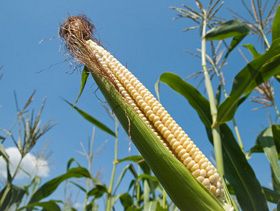 ally produced crops such as corn obviously have to be stored, writes Darrel Good. For corn producers, the question at harvest time will be who will store the portion of the crop which has not yet been sold?
ally produced crops such as corn obviously have to be stored, writes Darrel Good. For corn producers, the question at harvest time will be who will store the portion of the crop which has not yet been sold?That portion of the crop which has not been sold can be sold at harvest for someone else to store, or the producer can store the crop either on the farm or in commercial facilities. For the portion of the crop stored by the producer, the second question is whether the stored crop should be priced for later delivery or held unpriced.
That decision is influenced by the magnitude of the carry in the corn market, the cost of storage, and expectations about the change in corn prices after harvest. For corn that is stored and priced for later delivery, the price for later delivery obviously needs to exceed the cost of storage.
For forward cash sales, the differences between the forward bids for alternative delivery dates and the spot bid can be compared to the cost of storage to determine the returns to storage. The cost of storage incudes interest on the value of the stored crop and he magnitude of out-of-pocket costs to store the crop.
Those costs will likely be higher for off-farm storage than for on-farm storage since overhead costs of existing on-farm facilities would not be an out-of-pocket cost. Spot and forward bids in the cash market reflect current futures prices, the spot basis, the magnitude of the carry in the futures market, and the basis for later delivery.
Actual basis in the later delivery periods may differ from the basis reflected in the current forward bid. A producer who thinks the basis will be stronger than currently offered could also calculate the likely return to storage from hedging and then selling the crop at a stronger basis level.
Basis levels and basis patterns vary considerably by location so that an example of the likely returns to storage that is representative of all locations is not possible.
Harvest basis differences are especially large this year as cash bids reflect a tremendous variation in storage capacity, expected crop size, and transportation issues. In central Illinois, average harvest bids on July 25th were $0.31 under December futures.
With a July-December spread of nearly $0.27, the average harvest bid was $0.58 under July 2015 futures. If that basis is near $-0.10 in mid-June 2015, as it was this year, then the market is offering about $0.48 return for corn that is hedged and stored from harvest to mid-June.
With interest costs of about $0.11 ($3.40 @ 5 percent for 7.5 months), the return to storage would be positive with storage costs less than $0.37. With out-of-pocket on-farm storage costs likely to be considerably less than $0.37 for most producers, there is strong incentive to fully utilize that storage capacity. For corn already hedged in December futures, the market is encouraging the rolling of those hedges to deferred contracts if on-farm storage is available.
The corn market is currently encouraging storage of the 2014 corn crop and that decision could be made now with forward sales or by hedging in the futures market.
With expectations of a very large crop, however, the opportunity to capture a return to storage is not expected to disappear as the market will likely continue to offer positive returns to storage into harvest time. The question, then, is whether additional quantities of the crop should be sold at current price levels.
Corn prices between now and harvest will be determined mostly by the expected size of the crop. Based on market commentary and price behavior, the market appears to be expecting an average corn yield above 170 bushels, with a lot of forecasts pushing into the mid-170s.
Those expectations appear justified based on crop condition ratings, but the growing season still has a ways to go. Unusually cool temperatures in July have favored crop development during the pollination period and are characteristic of previous years with very high corn yields.
On the other hand, average July precipitation will likely end up well below average, which is not characteristic of previous very high yielding years (farmdoc daily, July 9, 2014). If dry conditions persist in August, the U.S. average yield will likely still be very high, but perhaps fall short of some of the current lofty projections. If so, prices would increase modestly going into harvest.
After harvest, corn prices will be influenced by the strength of demand and the pace of consumption. Corn consumption should be supported by a combination of strong domestic demand and the lowest prices in more than four years. If that is the case, corn prices would be expected to move modestly higher after harvest in a typical large-crop pattern. While there is still risk of lower prices, a little patience in pricing additional quantities of the 2014 corn crop appears warranted.







